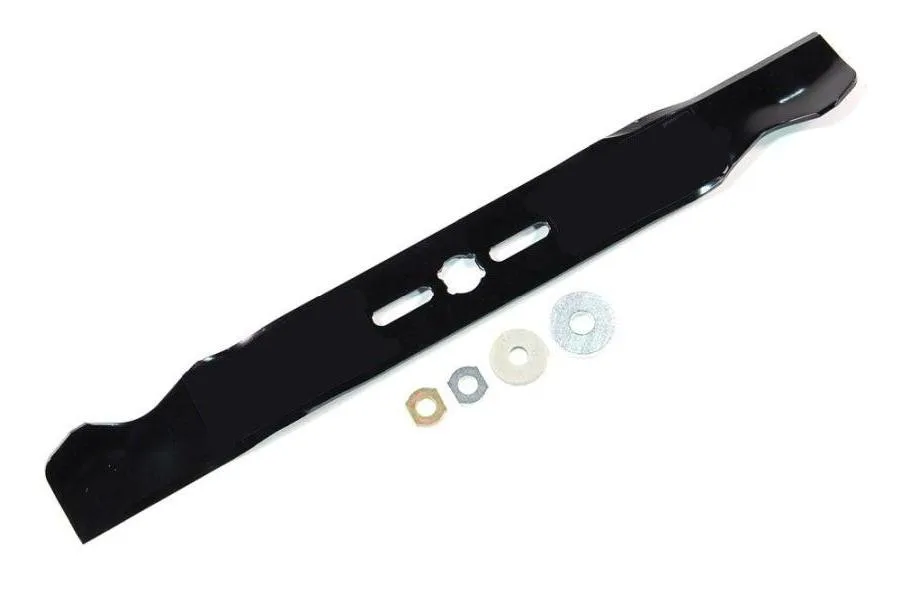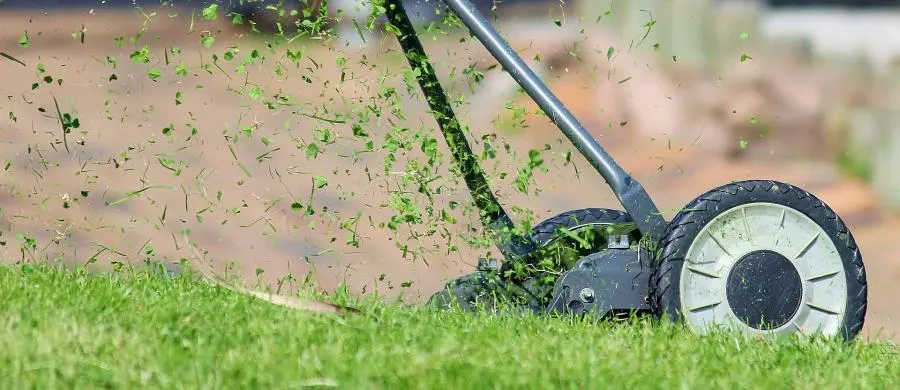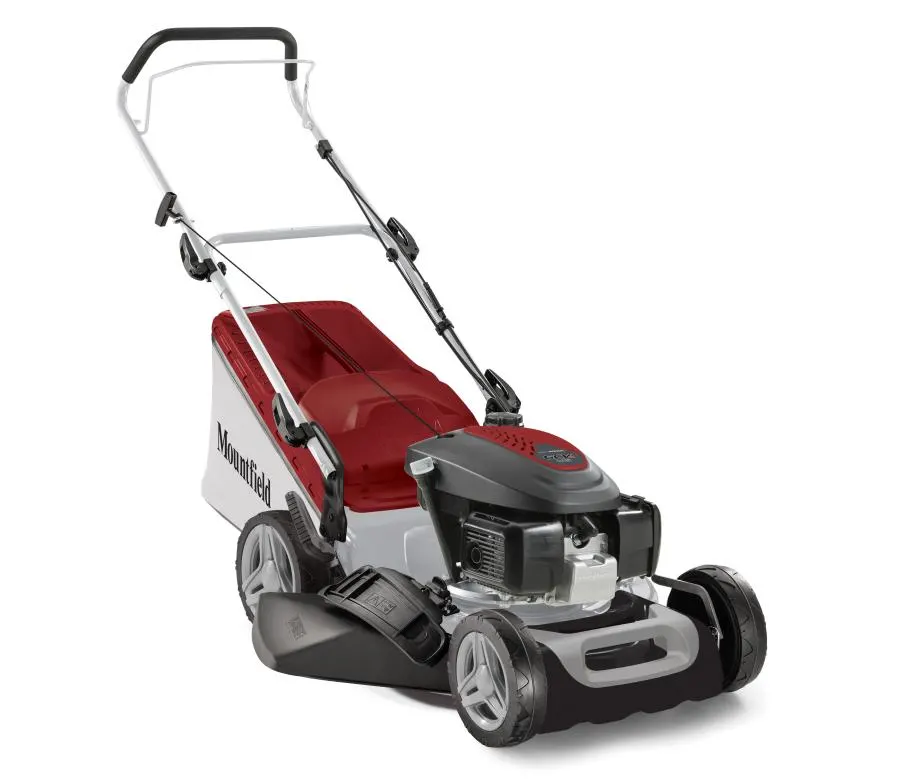Are you interested in maximizing the effectiveness of your lawn care routine? The size of your lawn mower blade is a critical factor. Rely on our expertise to guide you in selecting the perfect blade size for your needs.
What Size Lawn Mower Blade Do I Need?
For a small lawn, use a 16-inch reel mower blade. For a medium-sized lawn, use 20-22 inch blades. For a large-sized lawn, use 42-46 inch blades. Consider terrain, obstacles, soil conditions, and blade mulching/lift types. Adjust blade size as needed.

Transform your lawn maintenance experience. It’s not just about mowing; it’s about mowing right. The size of your blade plays a critical role in this process. Continue to explore how to choose the perfect blade size for your needs.
Contents
- 1 How to pick the correct mower and
blade size
- 1.1 ● Size of your lawn
- 1.1.1 – Small lawn (Under ¼ of an acre):
- 1.1.2 When choosing a new lawn mower blade, my top three tips are to consider the size and type of your lawn, choose the right blade for your needs, and always prioritize quality over price.
- 1.1.3 – Medium-sized lawn (Between ¼ and ½ acres):
- 1.1.4 – Large-sized lawn (More than an acre):
- 1.2 ● How much power do you require?
- 1.3 ● Maneuverability
- 1.4 ● The soil of your lawn
- 1.1 ● Size of your lawn
- 2 How do you pick the correct type of lawn mower blades?
- 3 Pros and cons of different-sized mowers
How to pick the correct mower and blade size
You have to consider the following factors when choosing the correct-sized mower for your lawn:
● Size of your lawn
It would be difficult to mow a huge lawn with a slight push mower with small blades, but cutting a tiny lawn with a monster-riding mower with 46-inch blades would be difficult.
Therefore, it is essential to keep the area of your lawn in mind when picking the correct lawn mower with the ideal blade size. Correct mower sizes as per the size of the lawn are as follows:
– Small lawn (Under ¼ of an acre):
A small lawn between 500 to 1000 square feet can be easily mowed using a manual reel mower, but you can also use a self-propelled one.
Reel mowers usually have 16-inch wide blades, and you have to push them forward to make them spin since they don’t have any engines or electric motors. You can also get a small self-propelled lawnmower for a lawn of this size.
When choosing a new lawn mower blade, my top three tips are to consider the size and type of your lawn, choose the right blade for your needs, and always prioritize quality over price.
– Medium-sized lawn (Between ¼ and ½ acres):
A lawn under 20000 square feet is too big to be mowed using a manual reel mower, and this is strictly the territory of a self-propelled walk-behind mower with between 20-22 inch blades. A self-propelled mower will move forward independently; you can control its motion using a lever.
However, you will still have to point it in the direction you want to mow. A 20-22-inch cutting diameter is big enough to cover a decent area, and with the added benefit of not having to push the mower forward, you can mow the lawn pretty quickly.
– Large-sized lawn (More than an acre):
If you are dealing with a lawn that is an acre or more, you will need a riding mower with at least 42-inch blades. If your lawn is way bigger than an acre, use a riding mower with a 46-inch knife.
More giant blades will allow you to cut grass with each pass, which will be handy if you mow a vast area. And since you are sitting on the mower as you mow the lawn, you can save yourself the hassle of walking back and forth and pushing a heavy machine over such a large area.

● How much power do you require?
If you use your mower on slopes or uneven surfaces, you will need a mower with a decent amount of power. And when it comes to power, bigger is better in the world of lawnmowers. You don’t want to get stuck in a section of your lawn on a slope with a heavy machine.
Therefore, if you have to mow up and down a slope, you are better off with a big riding mower with a rear engine with at least 13 horsepower. On the other hand, if you are mowing a small lawn with no slopes or uneven surfaces, a self-propelled mower with four horsepower can do the job.
● Maneuverability
When mowing around trees or other obstacles, you are better off with a smaller, more agile mower, such as a self-propelled one with a 22-inch blade.
A giant mower, such as a riding mower with a wide blade, will make it difficult to mow through narrow spaces and around obstacles such as stairs or plants.
While you can turn a smaller self-propelled mower whenever you want, a giant riding mower has a painfully wide turning radius, and you will have a hard time mowing grass with it if you have a lot of narrow spaces and obstacles to be navigated in your lawn.
If the soil on your lawn stays damp, using a larger mower can put extra strain on your lawn, and the soil will sink in, causing damage to the grass. Therefore, if your lawn stays damp most of the time, choosing a lightweight and smaller lawnmower is best.
With two decades of experience, I’ve learned that the size of your lawn, the type of grass, and the power of your mower are all crucial factors when choosing a lawn mower blade size.
● The soil of your lawn
How do you pick the correct type of lawn mower blades?
When you look specifically at the types of lawn mower blades, a few different kinds are available, each of which performs a specific function. Therefore, you must pick a lawnmower that has the type of blades that suit your usage requirements.
For instance, high-lift lawn mower blades are ideal if your mower has a bagger. These blades are designed with a larger wind wing, which increases airflow under the deck. This is beneficial for bagging as it helps to propel the grass clippings into the bagger.
However, these blades require more horsepower and may not be suitable for all mowers. On the other hand, flat lawn mower blades, also referred to as low lift, are ideal for side discharging.
• Understanding the Design of Lawn Mower Blades
These blades create a lower total lift due to the fin on the non-cutting edge side of the blade, which results in less airborne dust and debris.
If you have highly sandy soil conditions, you might want to use low lift blades to prevent sand from being thrown into the air and causing damage to your mower or property. Mulching blades, also known as 3-in-1 blades, can be used for discharging, bagging, or mulching the grass clippings.
These blades are designed with a more curved style surface, frequently including extra cutting surfaces along the edges. If you prefer mulching blades, ensure they suit your mower’s deck.
– Signs of Wear and Damage in Mower Blades
Inspecting and replacing your blades is essential if you notice any wear or damage. A dull blade will tear the grass, creating a ragged edge that makes the lawn look grayish brown. Also, remember to sharpen your knives in the fall before storing your mower for the winter.
Lastly, always ensure you have a good supply of replacement blades. This will ensure you’re never stuck or unable to mow your lawn due to a dull or damaged blade.
Whether you are looking for a replacement blade for your mower or buying a new one, it is a good idea to know what the different kinds of mower blades are actually for. Some common types of mower blades are as follows:
• Bagging blades:
If you want to prevent your lawnmower from spreading the cut grass all over the lawn, then bagging blades would be the perfect solution. Bagging blades have a specific shape that allows them to scoop up grass clippings, send them into the bag, and avoid spreading them.
A bagging blade is either going to have a wing or a specialized bend on the top side, which allows it to suck up the clippings as they get cut. It is important to note when shopping for bagging blades or a mower with a dedicated blade.
You might find multiple function blades that perform other functions along with bagging since very few dedicated bagging blades are available. Moreover, you can discover bagging blades for decent-sized walk-behind mowers and riding mowers.
• Mulching blades:
These blades have been made for people who don’t use a bag with their mower and like to discharge the grass clippings into the lawn.
The shape of a mulching blade is designed to circulate the grass clippings inside the mower’s deck multiple times after being cut before they get discharged. By lifting the pieces of cut grass again, the mulching blade can cut the grass into smaller released pieces.
– The Process of Mulching Blades
Since the pieces of grass have been made very small after passing through a mulching blade multiple times, they will decompose quickly and won’t be very noticeable. Mulching blades are usually used without a bagger, but if you want, you can also use a bag in combination with a mulching blade.
However, remember that a mulching blade’s suction power will not be as mighty as a dedicated bagging blade’s.
Another thing to remember when buying a mulching blade is that if you mow your lawn when the grass gets a bit taller, it won’t do much good since it can’t cut longer grass blades into tiny pieces.
Based on my experience, I’d say that the frequency of sharpening lawn mower blades depends on usage, but generally, at least once a season is a good rule of thumb.
• Standard or lifting blades:
These blades are the most commonly used, and most mowers are sold with a standard or lifting blade installed. The purpose of a standard blade is to raise the grass upward so that it can be appropriately cut and discharged from underneath the mower’s deck.
The lifting action of a standard blade occurs thanks to curved edges that produce enough upward airflow to keep the grass pointing upward for a cleaner cut. Now, when it comes to lifting, powerlifting blades are categorized into three categories which are:
– Low lift blades:
Low-lift blades perform precisely as their name suggests. They produce low lift under the deck since their edges are not curved. These low-lift blades are ideal for mowers that don’t have a bagging option because they can quickly expel the cut grass from underneath the deck.
And because low-lift blades don’t produce much suction, they are ideal for sandy lawns as less sand will be lifted upwards when the mower passes over it. So, a low lift blade is perfect if you are trying to prevent debris and dust from flying around when mowing a drier sandy lawn.
– Medium lift blades:
If you are looking for a mower that produces more suction to cut grass better, then medium-lift blades are the way to go.
Medium lift blades fit into most normal mowing scenarios because they produce decent suction that allows you to use a bag with them. With a medium-lift blade, you can cut a lawn with moderately thick grass without requiring a mower with much horsepower.
– High lift blades:
Great lift requires excellent power, and high lift blades are meant to be used with lawnmowers with plenty of horsepower to support a high lift blade. Since they produce plenty of lift, they can be comfortably used with a bagger, and you can cut very thick and tall grass easily using a high-lift blade.
The most significant advantage of high lift blades is that they prevent the grass and debris from clumping inside the mower’s deck thanks to their strong airflow.
The ideal use scenario for a high lift blade is when you need a bagger because a high-life mower cannot discharge grass clipping from underneath the deck.

Pros and cons of different-sized mowers
Whether a push, self-propelled, or riding mower, each size has pros and cons. Before buying a specific-sized mower, you should know its strengths and weaknesses to avoid any later surprises.
● Push mowers:
A push mower doesn’t have an engine to spin its blades or to move it forward when mowing. Most push mowers have reel blades that rotate in the direction you move them in and cut grass, similar to how scissors do.
Pros
- No gas is required to run them since you are pushing and cutting the grass by moving it forward.
- While engine-powered mowers are known for their loud noise and vibrations, push mowers are primarily silent and make very little noise when mowing the lawn.
- They don’t cost much, and you can buy a decent-quality manual push mower for around $100.
- It is very environmentally friendly, and people also use push mowers to exercise while mowing the grass.
- Maintenance is cheap since there is no engine or tires to maintain.

Cons
- You can’t use a manual mower to cut tall or thick grass because it lacks the necessary power to cut through very dense grass.
- Push mowers are not precise and cut the grass unevenly, making your lawn look messy.
- It can’t be used on a lawn with many twigs and fallen leaves.
- You can’t cut the grass short, and it tends to leave it taller than an engine-powered mower.
- The blades aren’t very wide, so you have to make a lot of passes to cover the whole lawn.
- They require too much effort to mow the lawn, making it a chore.
● Self-propelled mowers:
These mowers have rotating blades powered by an engine, and they also move forward on their own because the engine that drives the blades also propels the mower forward.
Pros
- You can mow an enormous lawn using a self-propelled mower since you don’t have to put any effort into pushing it.
- It can cut taller and thicker grass thanks to rotating blades powered by an engine.
- Cut the grass evenly and smoothly.
- It can change directions quickly and is very maneuverable.
- They allow you to collect the cut grass inside a bag, reducing the mess.
- They have more giant blades that allow you to cover more area than a push mower.

Cons
- It can be difficult to maintain with many more things that can break down.
- They are expensive compared to manual mowers, and you might have to pay around $500 for a decent self-propelled mower.
- It can rip and tear the grass if the blade is not sharp enough.
- Since the same engine drives both the blade and mower, it can lose power on slopes.
- You have to walk faster to keep up with the mower’s speed.
● Riding mowers:
Riding mowers allow you to sit on them as you mow the lawn, and you can steer them just like any other vehicle.
Pros
- It can easily mow a big lawn that stretches more than an acre.
- It can easily mow an uneven lawn.
- It has very wide blades that allow you to cover more area in a single pass compared to any other type of mower.
- You barely have to exert any energy mowing the lawn, making the process enjoyable.
- Thanks to its powerful engine, you can use a riding mower for hauling and towing things around your lawn.
Cons
- They require a lot more gas to run compared to walking behind mowers.
- The maintenance cost is high, and you must maintain many more parts.
- A decent riding mower starts at around $1500, making it a considerable investment.
- It cannot be easy to store and require their own storage space.
- They are very loud compared to smaller types of mowers.


Would a riding mower be too much for a medium-sized lawn?
For a medium-sized lawn, a riding mower with a 20-22 inch blade would be perfect. It will save you time and effort while keeping your lawn looking pristine. Enjoy the benefits of a riding mower!
I will definitely be more mindful of the type of blade I choose for my lawn after reading this article.
Thank you for reading our article, Bonnie! We’re delighted to hear about your intention to be more mindful of choosing the right blade for your lawn. Keep up the great work!
Great job explaining the different types of blades and their purposes.
Thank you for your feedback, Don! I’m glad you found the information on different blade types helpful. Let me know if you have any other questions or need further clarification.
What is the best type of mower for a hilly lawn?
Consider a self-propelled mower with 20-22 inch blades for a hilly lawn. The power and maneuverability will help you efficiently tackle the terrain. Happy mowing!
I loved the video link that provided visual examples of different mower blades.
Thank you, Eva! We’re glad you found the video helpful. Consider the size of your lawn when selecting a mower blade. Happy mowing!
Can I use a self-propelled mower on a large lawn?
Yes, a self-propelled mower works well for large lawns. For optimal results, choose a mower with 42-46 inch blades based on your lawn’s size and terrain. Happy mowing!
How often should I sharpen my mower blades?
Hi Travis, consider sharpening your mower blades at least once a month during mowing season to ensure a clean cut. This will help maintain the health and appearance of your lawn.
What is the best blade size for mulching?
For mulching, consider a blade size based on the size of your lawn: 16-inch for small, 20-22 inch for medium, 42-46 inch for large. Factors include terrain and obstacles. Happy mowing!
Are there any safety tips to keep in mind when using different blade sizes?
Selecting the appropriate blade size for your lawn depends on factors like lawn size, terrain, and obstacles. For small lawns, consider 16-inch blades and adjust accordingly. Find the right fit for your mowing needs!
The section about the pros and cons of different-sized mowers was very insightful.
Thank you, Shawn! We’re glad you found our insights helpful. Let us know if you have any more questions about maximizing your lawn care routine.
I found the comparison between push, self-propelled, and riding mowers very helpful in deciding which one is best for me.
Thank you, Duane! We’re glad you found our comparison helpful. Remember, the right blade size is crucial for lawn maintenance. Keep mowing right!
Thank you for outlining the different factors to consider when choosing a mower blade size.
Thank you, Vernon! Choosing the right blade size is crucial for lawn care success. I’m glad you found the information helpful. Keep mowing right!
Can I use a bigger blade on a small lawn for faster mowing?
Selecting the right blade size for your lawn is crucial. For a small lawn, a 16-inch reel mower blade is ideal. Size up as needed for a positive mowing experience.
I never knew the size of the blade mattered so much, thanks for the information!
Thank you, Sofia! We’re glad you found the information helpful. Let us know if you have any more questions about maximizing your lawn care routine.
This article has helped me understand the importance of considering the terrain when choosing a mower blade size.
Thank you, Jeffrey! We’re glad you found the article helpful in choosing the right mower blade size. Keep mowing right!
Should I consider the noise level of the mower when choosing a blade size?
Consider noise levels for a peaceful mowing experience. Select blade size based on lawn size. As we advise, choose a 20-22 inch blade for a medium lawn and enjoy efficient mowing without disturbance.
Do you have any recommendations for maintaining the blades?
To maintain your blades, keep them sharp and balanced. Check for wear and damage regularly, and replace as needed. Sharpen blades in the fall before storing for winter. Happy mowing!
I appreciate the tips on how to select the correct blade size based on the size of my lawn.
Thank you for your kind words, Brittany! I’m glad you found the tips helpful in selecting the correct blade size for your lawn. Happy mowing!
Are there specific types of blades for different grass types?
When selecting a lawn mower blade, consider the size of your lawn and terrain. For a small lawn, 16-inch blades are ideal; for larger areas, 42-46 inch blades work best. Adjust as needed.
This article was very informative about choosing the right blade size for different lawn sizes.
Thank you, Guy Hart! We’re glad you found our article informative. Let us know if you have any other questions about lawn mower blades. Happy mowing!